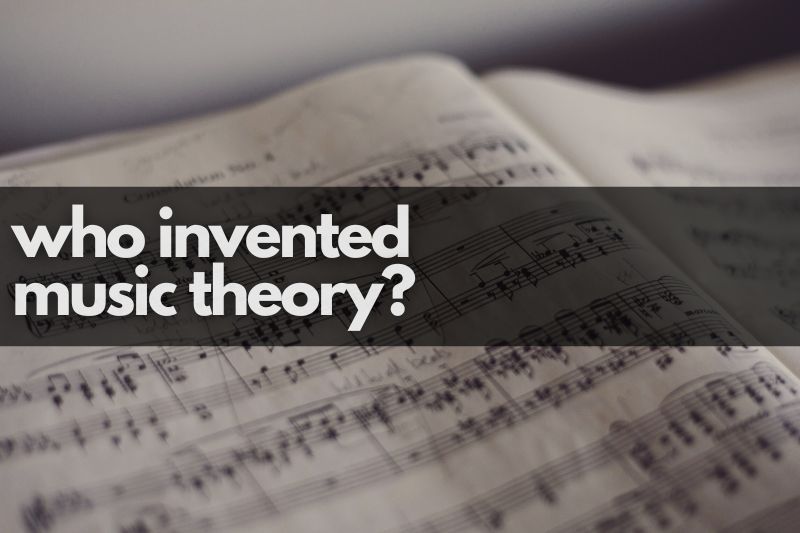Who Invented Music Theory? Guide Of Musical History

Music theory was born from ancient thinkers’ efforts to understand the sounds surrounding them.
Among the earliest known theorists were Greek scholars like Pythagoras, who explored the mathematical relationships between pitches. His discoveries about harmony laid the groundwork for many fundamental concepts still taught in music classrooms today.
While no single person invented all of music theory, its development is attributed to a blend of contributions from cultures worldwide, including Chinese, Indian, and later European scholars.
KEY TAKEAWAYS
Who Invented Music Theory?
I’m afraid there’s no short answer to this question!
From the complexities of harmony and rhythm to the elegant structure of notation, music theory expanded as musicians and theorists sought to make sense of the art and science of sound. This evolution was not (and is not) just an academic exercise; it has profoundly impacted various musical genres, influencing how they are created and understood.
Understanding this historical context pulls the curtain back on a timeless art form, showing you that music theory is as dynamic and varied as the music it seeks to decode. Whether you’re a musician or just curious about how compositions come to life, the story of music theory offers fascinating insights.
Origins of Music Theory
Music theory’s roots stretch back to ancient civilizations and evolved significantly through Greek influence and the religious practices of medieval times. These periods contributed to the framework and evolution of music theory as we know it today.
Ancient Civilizations and Early Theorists
Music played a vital role in various cultures in the ancient world, serving both practical and spiritual purposes. Early evidence shows that music was integral to religious ceremonies and rituals in places like Mesopotamia, Egypt, and China. These civilizations viewed music as a form of expression and a connection to the divine, using vocal music and instrumental music to communicate spiritual and cultural narratives.
Theorists in these societies were particularly fascinated by the relationship between music and mathematics, exploring how structured sound patterns could be quantified and understood.
The Babylonians, for example, used a numeric system to calculate musical intervals, a precursor to the musical scale system we use today. Their efforts laid the groundwork for understanding the half step, a critical component in constructing scales and chords, including major and minor chords.
Such early work represents the first step in what would become a sophisticated field of music theory. These contributions underscore the universal desire to decode the structures of music and create a shared system for its use across cultures.
The Greek Influence on Music Theory
Ancient Greece occupies a pivotal place in the history of music theory. Thinkers like Pythagoras looked deep into the mathematical foundations of sound. Pythagoras’ experiments with string lengths led to the discovery of harmonic ratios, such as the interval of a minor third, which form the basis of scales and chords.
His work is one of the earliest known examples of music being systematically studied, bridging the gap between art and science.
I’ve always been intrigued by how they used the Greek alphabet to notate sounds, a primitive but effective precursor to the system of notation we recognize today. Figures like Aristoxenus expanded on this foundation, writing extensively about rhythm, scales, and harmony.
His insights into musical intervals and melodic construction were among the first formal attempts to theorize about the collection of notes that make up a piece of music.
This era also saw a merging of disciplines, as music was studied alongside mathematics, astronomy, and philosophy. The Greeks’ intellectual approach to music allowed for exploring its theoretical aspects in different ways, laying a foundation for later theorists who would refine and expand these ideas.
Greek contributions to the creation of music and its theoretical underpinnings continue to influence how we study and compose today.
Medieval Times and the Church’s Role
In medieval times, the Church profoundly impacted the development of music theory, shaping the evolution of musical forms and the system of scales used in Western music.
Pope Gregory is often credited with organizing the Gregorian Chant in the sixth century, a monumental effort that brought uniformity to church music. Gregorian Chant utilized a system of church modes, which can be thought of as the earliest framework for minor keys and major keys in Western music.
This plainchant, a form of vocal music, relied heavily on the system of notation developed during this period. This system allowed for the consistent transmission of melodies across the growing Christian world. Over time, these notations evolved into more detailed representations of pitch and rhythm, enabling the precise documentation of musical compositions.
During the Middle Ages, music was standardized for liturgical purposes and to unify communities through shared melodies and hymns. This process involved codifying the most common scales and introducing concepts later supporting instrumental music and polyphonic compositions.
By aligning music structures with the spiritual and cultural needs of the time, the Church played a pivotal role in laying the groundwork for basic music theory as we know it.
The printing press of the 15th century would later amplify this standardization, ensuring that the foundational elements developed in the medieval era endured and became accessible to musicians across Europe.
Evolution of Musical Notation
From Ancient Symbols to Guido of Arezzo
Musical notation began as simple symbols that helped early musicians remember the melodies and rhythms they played. One of the earliest known examples is the Seikilos Epitaph, carved on a tombstone with musical notes and lyrics from Ancient Greece. These symbols laid the groundwork for future systems.
In the early medieval period, Guido of Arezzo made significant contributions by developing a method that used lines and spaces to indicate pitch, known as staff notation. This innovation allowed musicians to convey musical ideas more accurately across distances and helped standardize music writing in Europe.
Renaissance Innovations and Mensural Notation
During the Renaissance, music notation became more sophisticated to meet the needs of polyphonic music, which involves multiple independent melody lines. Mensural notation was developed to indicate rhythm more precisely than ever before. This system included notes of varying durations and introduced the use of time signatures.
Renaissance composers could use these advancements to write complex choral works, with each voice part notated separately. This facilitated the creation of intricate musical textures that defined Renaissance music. The period marked a significant leap in notational complexity, supporting greater musical expression.
Baroque and Classical Periods
In the Baroque period, notation continued to evolve as composers required more detail for dynamics, articulation, and ornamentation. The introduction of baroque ornamentation symbols allowed for the expressive performance style characteristic of the era. The notation system expanded to include instructions for instruments newly standardized in orchestras.
During the Classical period, further refinements in music notation allowed composers such as Mozart and Beethoven to communicate nuanced musical ideas. Notation became more precise, incorporating detailed dynamic markings and expressive terms. This precision helped shape the Classical music era’s clarity and formality, setting the stage for future musical composition and notation innovations.
Key Concepts in Music Theory
Music theory provides a foundation for musicians to communicate and build upon ideas. Key concepts include musical scales, chords, harmony, and time signatures.
Understanding Scales and Modes
Scales are the foundation of musical compositions, organizing notes into a structured sequence of pitches. They form the basis for harmony, melody, and rhythm. Mastering scales is a critical first step in understanding basic music theory and creating cohesive, expressive pieces.

Major & Minor Scales
The distinction between major and minor chords has its roots in their respective scales.
Major scales, known for their bright and uplifting sound, are widely used in genres ranging from classical to pop.
Minor scales evoke a sense of melancholy or introspection, and they are often used in genres that require emotional depth, such as jazz or film scores.
The unique tonal qualities of these scales arise from the arrangement of whole steps and half steps between their notes. For instance, a minor third interval within a minor scale gives it its signature somber tone, a sound that has resonated through the world of music for centuries.

The Diatonic Scale
The diatonic scale is one of the most influential frameworks in Western music. It encompasses seven notes within an octave and blueprints countless musical scenes, from classical symphonies to modern rock ballads.
The diatonic scale’s structure—composed of a pattern of whole and half steps—is a universal template for creating melodies and harmonies. Its influence spans a long time, stretching back to ancient music and shaping how we approach music today.
The diatonic scale forms the basis for major and minor scales and more complex musical forms that rely on its harmonic richness.

Modes
Modes add depth and variety to music by offering unique musical forms that begin on different starting points of a scale. These variations transform the character and mood of a piece, making them invaluable tools in both composition and performance.
For instance, the Dorian mode, derived from the diatonic scale but starting on the second degree, creates a sound that blends the optimism of a major scale with the introspection of a minor scale.
Other modes, such as Phrygian or Mixolydian, provide different ways to approach the same notes, opening up endless possibilities for musical exploration.
Modes have been used for a long time, dating back to ancient music, and continue to inspire both traditional and contemporary musical scenes. Whether used in a simple folk tune or an elaborate jazz improvisation, modes demonstrate the enduring flexibility of music’s structures.
Chords and Harmony
Chords are built from combinations of pitches that sound together.
Major chords typically produce a bright sound; minor chords offer a darker, more contemplative feel. The arrangement of these chords creates chord progressions, essential for constructing musical narratives.
The intervals, like the perfect fourth and perfect fifth, define the relationships between notes and underpin harmony. When these intervals combine into triads, they create the fundamental chords that you hear in countless musical pieces.
Harmony is the result of multiple chords interacting within a composition.
Time Signatures and Rhythm
Time signatures organize a piece’s rhythm by defining the number of beats in each measure.
Common time signatures like 4/4 or 3/4 provide structure and predictability. This framework helps you understand where accents fall, creating the pulse of the music. Rhythm emerges from the interaction of note durations within these measures. It includes patterns of beats and offbeats, forming the groove or flow of a piece.
Mastering time signatures and rhythm brings consistency and dynamic energy to your music, enabling creativity while maintaining structure.
Music Theory’s Impact on Musical Genres
How Music Theory Shaped Classical Music
In classical music, theory serves as the backbone for many compositions.
The Baroque era, emphasizing harmony and counterpoint, demonstrates this foundational role. Composers like Johann Sebastian Bach used music theory to weave intricate melodies and harmonies that highlighted the complexities of the string quartet.
Music theory continued to evolve during the 19th and 20th centuries, allowing composers to experiment with novel structures and forms. This evolution introduced more emotional depth in symphonic pieces. Music educators during this time laid the groundwork for understanding these complex theories, influencing generations of musicians who carried these principles forward.
Influence on Modern and Popular Music
Music theory is equally transformative in modern and popular music. It provides a common language among musicians in rock bands or electronic dance music producers. The ability to understand chord progressions and rhythmic patterns enhances creativity and innovation.
With the proliferation of digital music tools, theory becomes essential in creating electronic music that resonates across cultural boundaries. Popular music allows artists to blend styles and genres, creating hits that appeal to a wide audience. Music educators today emphasize theory to preserve traditional forms and inspire new expressions in modern compositions.
Music Theory in Practice
The Role of Music Education
Music theory is a foundation for music education. It helps you grasp the basic elements like melody, harmony, and rhythm.
Traditional school methods often involve reading and analyzing scores, which ensures you can follow and decode compositions effectively. On the other hand, private lessons provide a more personalized approach, focusing on specific needs and styles you might be interested in.
The emphasis on music theory in education enables you to build a well-rounded skill set. By understanding the rules, you can better appreciate and innovate within them, fostering both your technical proficiency and creative process.
The Professional Musician’s Toolkit
Music theory is an indispensable tool for professional musicians. It equips you with the ability to compose, arrange, and interpret music across various genres. This knowledge lets you adapt quickly in dynamic performance settings.
Understanding the theory of music, like chord progressions or key signatures, allows you to work collaboratively in rehearsals or studio sessions. Here, theory is not just about rules; it’s also about communication.
Do You Really Need To Study Music Theory?
Throughout my music career, I’ve heard the same question many times – Is it really necessary for you to study and understand music? Can’t you just follow your feelings and truly create music?
My answer to that question always is this:
Imagine going to a foreign country with a language based on grammar entirely different from your native tongue. If you don’t study the basic rules of the language, you won’t get very far in communicating in a foreign language with the locals.
On the other hand, if you spend time studying the structure and rules of the language, you’ll be able to do more than repeat random phrases you hear around you; you’ll be able to completely take part in conversations and truly begin to learn and understand the language.
Music is no different! In fact, I’d go as far as describing music as an international language. It crosses borders and cultures. So yes, it absolutely is worth investing your time into studying music theory. I promise you it will only strengthen your creativity and inspiration.
Incorporating music theory into your practice enriches your musicianship and enhances your versatility. It forms the backbone of your creation, ensuring your work remains compelling and cohesive. Whether performing, recording, or teaching, theory supports every aspect of your professional music career.
Instruments and Music Theory
Percussion and Rhythm Foundation
Percussion instruments are essential for rhythm. Drums, tambourines, and maracas create the heartbeat of music. Their beats are the foundation of rhythm in various music forms. You often use these instruments to maintain tempo, a crucial element in ensemble performances.
By keeping time, percussion instruments help you understand the rhythmic structure of a piece. These instruments guide musicians and listeners in identifying beats and measures. Percussion is fundamental for appreciating the complexity of rhythm, which is a core component of music theory.
Key Instruments and Melodic Theory
The melodic theory is closely linked to key instruments like pianos and harps. These instruments highlight melodic development through white and black keys. Each key represents a musical note, allowing you to explore scale and harmony.
Key signatures influence music pieces’ tonality, while pianos offer a practical way to comprehend their structure. You gain insights into melody and harmony intricacies by interacting with white and black keys. Key instruments are vital in demystifying the concepts that underpin music theory. This hands-on interaction helps you effectively engage with and learn the specifics of musical notes and scales.
The Future of Music Theory
Music theory is constantly evolving, shaped by technological advances and diverse cultural influences. This progression impacts how you learn and interact with the language of music in modern times.
Technological Advances and New Perspectives
As technology advances, how we engage with music theory is transforming. Digital composing platforms allow you to experiment with sound innovatively. AI will undoubtedly change how music is created and made.
This technological shift supports the development of music theory by providing new methods for analysis and composition.
You can now visualize music through software that offers insights into complex structures and harmonies. These advancements also introduce fresh perspectives in Western music theory, enabling the incorporation of unconventional sounds and enhancing your creative process.
Global Influence and Music Theory Today
Music theory expands beyond its traditional roots in Western Europe, increasingly embracing global perspectives. Today influences from African, Asian, and Latin American music add richness and complexity to the language of music.
This globalization fosters mutual enrichment as diverse musical traditions intersect with the common practice framework. Such cross-cultural exchanges allow for a broader understanding and application of music theory in different contexts, enriching how people experience and interpret music today.
Conclusion
So, who invented music theory? You’ve learned that no one person is responsible for inventing music theory.
As you begin studying music theory, it becomes clear that this field reflects humanity’s endless creativity and curiosity.
From the ancient Greeks’ early exploration of harmony to the system of scales and notation we use today, music theory has provided the foundation for countless musical compositions. It has transformed over centuries—from the baroque music of the 17th century to the innovations of the 20th century—adapting to different systems and cultural influences.
I’m amazed at how these concepts connect us to the rhythmic sounds and melodic structures that resonate deeply within the human brain, no matter your country or culture.
Whether engaging with traditional methods or experimenting with modern approaches, understanding music theory is one of the most important things you can do in your music career to unlock new ways of creating and appreciating music.
Frequently Asked Questions
Who is considered the father of music theory?
Pythagoras, a Greek philosopher from the sixth century BC, is often credited with laying the foundation for music theory. His work on the mathematical relationships between notes formed the basis for later explorations in musical structure.
What are the origins of music theory?
The origins of music theory can be traced back to ancient Greece, where thinkers like Pythagoras and Aristoxenus began exploring its mathematical and theoretical aspects. Their early work paved the way for the development of systematic musical frameworks.
Who are some of the major contributors to the development of music theory?
Significant contributors include Greek philosophers like Pythagoras, who explored mathematical relationships, and Aristoxenus, who documented rhythmic and harmonic theories. Later, medieval scholars like Boethius furthered these ideas, incorporating them into broader educational contexts.
How did classical music influence the evolution of music theory?
Classical music played a crucial role in shaping music theory by formalizing scales, harmonies, and counterpoint techniques. This period saw the codification of musical notation and the establishment of standardized tuning, which influenced modern theory.
Can you list some early texts or figures pivotal to music theory?
Early texts include Aristoxenus’s Harmonic Elements and writings by Boethius, who introduced Greek ideas to medieval Europe. These works, alongside treatises by later figures such as Guido of Arezzo, were pivotal in shaping Western music theory.
How has music theory evolved from ancient times to the modern era?
Music theory has evolved from the ancient focus on mathematical ratios to encompass diverse styles and notations. While initially centered on Western classical traditions, it now includes global music genres, utilizing advanced theoretical frameworks to analyze and create music.





